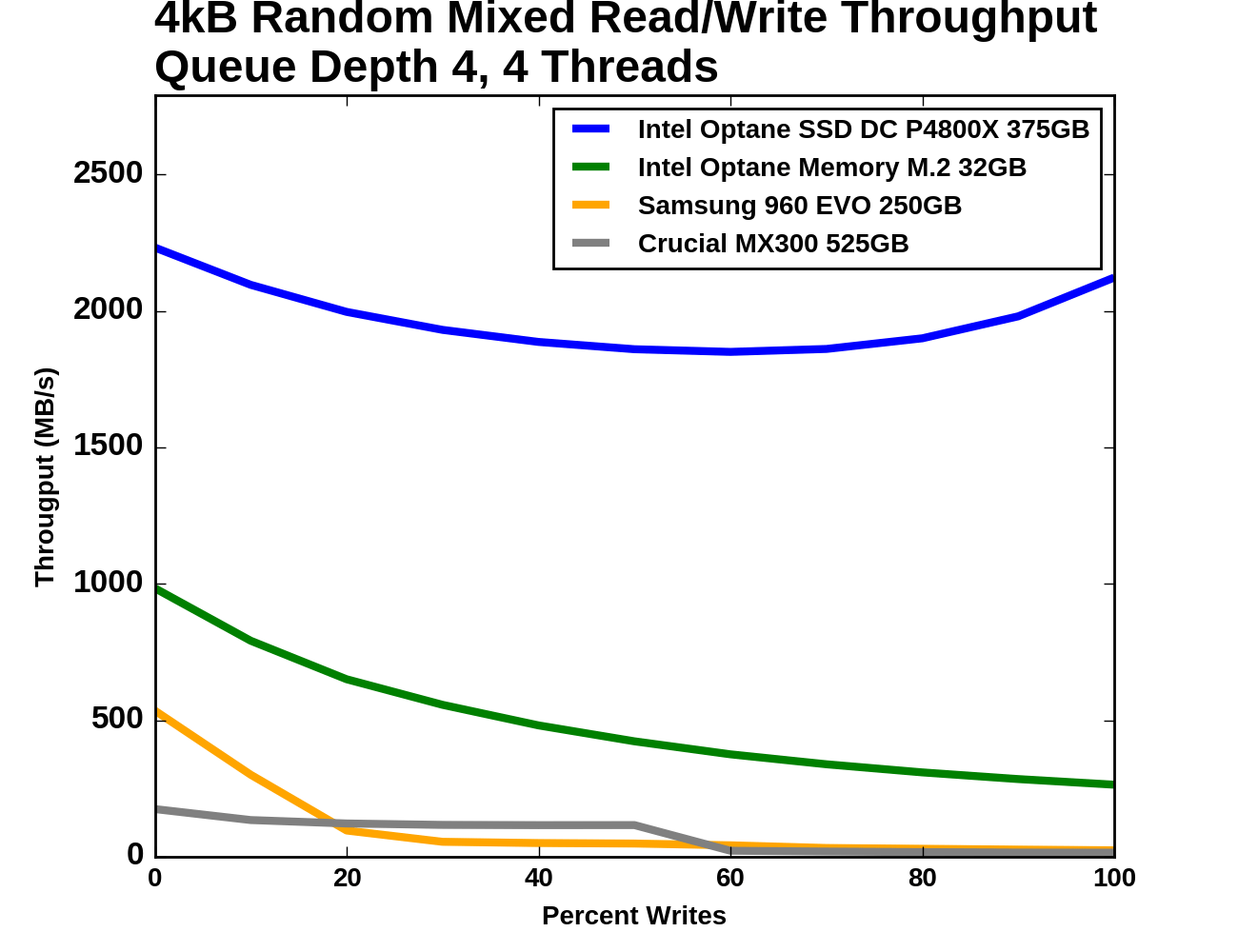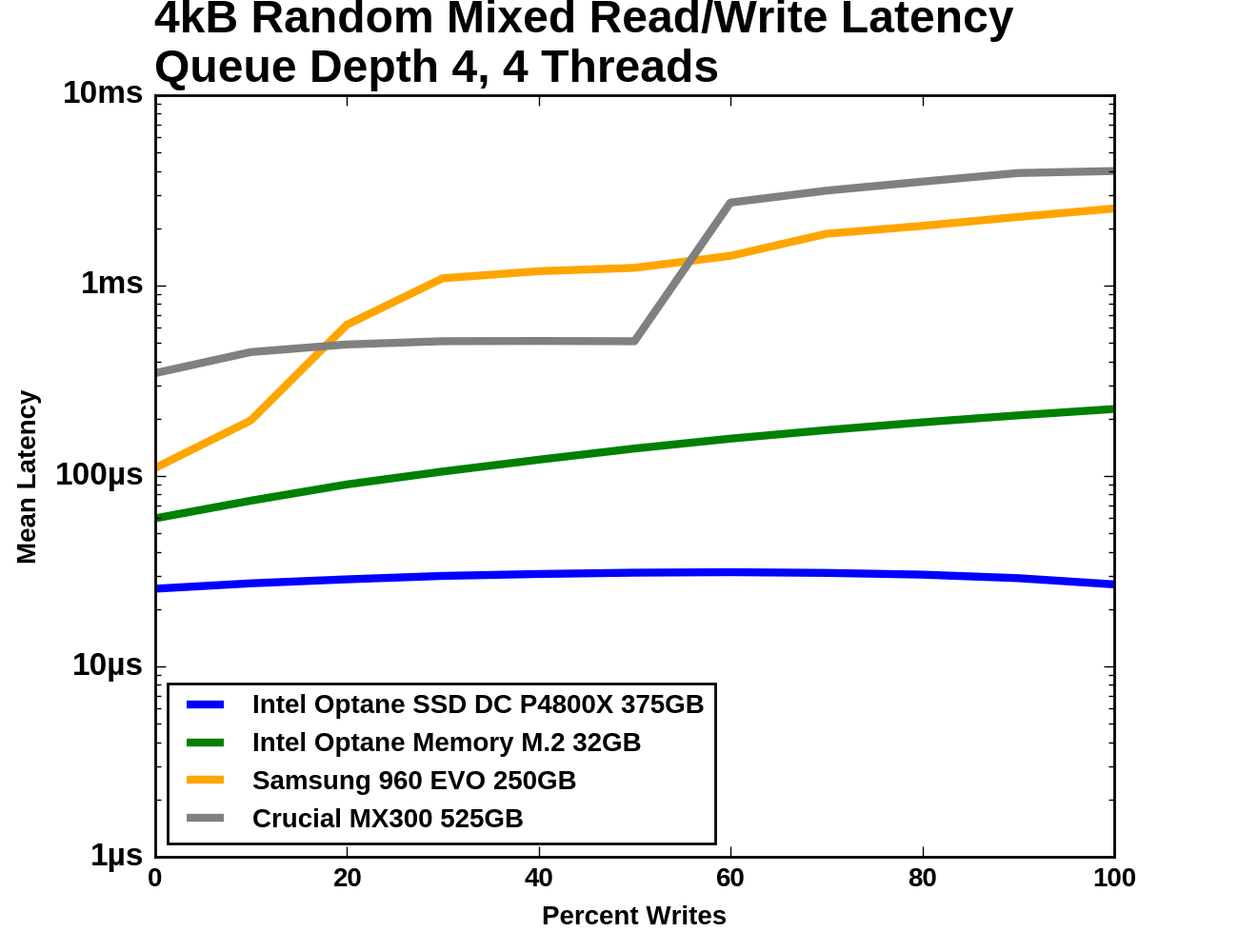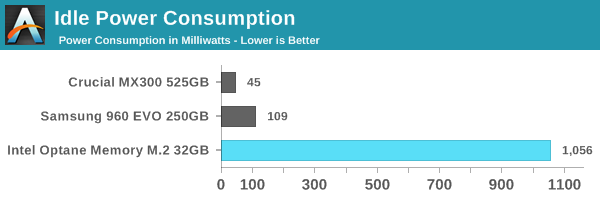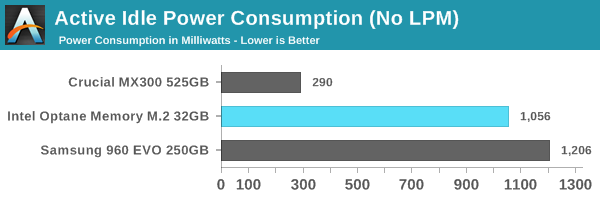The Intel Optane Memory (SSD) Preview: 32GB of Kaby Lake Caching
by Billy Tallis on April 24, 2017 12:00 PM EST- Posted in
- SSDs
- Storage
- Intel
- PCIe SSD
- SSD Caching
- M.2
- NVMe
- 3D XPoint
- Optane
- Optane Memory
Mixed Read/Write Performance
Workloads consisting of a mix of reads and writes can be particularly challenging for flash based SSDs. When a write operation interrupts a string of reads, it will block access to at least one flash chip for a period of time that is substantially longer than a read operation takes. This hurts the latency of any read operations that were waiting on that chip, and with enough write operations throughput can be severely impacted. If the write command triggers an erase operation on one or more flash chips, the traffic jam is many times worse.
The occasional read interrupting a string of write commands doesn't necessarily cause much of a backlog, because writes are usually buffered by the controller anyways. But depending on how much unwritten data the controller is willing to buffer and for how long, a burst of reads could force the drive to begin flushing outstanding writes before they've all been coalesced into optimal sized writes.
This mixed workload test is an extension of what Intel describes in their specifications for the Optane SSD DC P4800X. A total queue depth of 16 is achieved using four worker threads, each performing a mix of random reads and random writes. Instead of just testing a 70% read mixture, the full range from pure reads to pure writes is tested at 10% increments. These tests were conducted on the Optane Memory as a standalone SSD, not in any caching configuration. Client and consumer workloads do consist of a mix of reads and writes, but never at queue depths this high; this test is included primarily for comparison between the two Optane devices.
 |
|||||||||
| Vertical Axis units: | IOPS | MB/s | |||||||
At the beginning of the test where the workload is purely random reads, the four drives almost form a geometric progression: the Optane Memory is a little under half as fast as the P4800X and a little under twice as fast as the Samsung 960 EVO, and the MX300 is about a third as fast as the 960 EVO. As the proportion of writes increases, the flash SSDs lose throughput quickly. The Optane Memory declines across the entire test but gradually, ending up at a random write speed around one fourth of its random read speed. The P4800X has enough random write throughput to rebound during the final phases of the test, ending up with a random write throughput almost as high as the random read throughput.
 |
|||||||||
| Mean | Median | 99th Percentile | 99.999th Percentile | ||||||
The flash SSDs actually manage to deliver better median latency than the Optane Memory through a portion of the test, after they've shed most of their throughput. For the 99th and 99.999th percentile latencies, the flash SSDs perform much worse once writes are added to the mix, ending up almost 100 times slower than the Optane Memory.
Idle Power Consumption
There are two main ways that a NVMe SSD can save power when idle. The first is through suspending the PCIe link through the Active State Power Management (ASPM) mechanism, analogous to the SATA Link Power Management mechanism. Both define two power saving modes: an intermediate power saving mode with strict wake-up latency requirements (eg. 10µs for SATA "Partial" state) and a deeper state with looser wake-up requirements (eg. 10ms for SATA "Slumber" state). SATA Link Power Management is supported by almost all SSDs and host systems, though it is commonly off by default for desktops. PCIe ASPM support on the other hand is a minefield and it is common to encounter devices that do not implement it or implement it incorrectly, especially among desktops. Forcing PCIe ASPM on for a system that defaults to disabling it may lead to the system locking up.
The NVMe standard also defines a drive power management mechanism that is separate from PCIe link power management. The SSD can define up to 32 different power states and inform the host of the time taken to enter and exit these states. Some of these power states can be operational states where the drive continues to perform I/O with a restricted power budget, while others are non-operational idle states. The host system can either directly set these power states, or it can declare rules for which power states the drive may autonomously transition to after being idle for different lengths of time. NVMe power management including Autonomous Power State Transition (APST) fortunately does not depend on motherboard support the way PCIe ASPM does, so it should eventually reach the same widespread availability that SATA Link Power Management enjoys.
We report two idle power values for each drive: an active idle measurement taken with none of the above power management states engaged, and an idle power measurement with either SATA LPM Slumber state or the lowest-power NVMe non-operational power state, if supported. These tests were conducted on the Optane Memory as a standalone SSD, not in any caching configuration.


With no support for NVMe idle power states, the Optane Memory draws the rated 1W at idle while the SATA and flash-based NVMe drives drop to low power states with a tenth of the power draw or less. Even without using low power states, the Crucial MX300 uses a fraction of the power, and the Samsung 960 EVO uses only 150mW more to keep twice as many PCIe lanes connected.
The Optane Memory is a tough sell for anyone concerned with power consumption. In a typical desktop it won't be enough to worry about, but Intel definitely needs to add proper power management to the next iteration of this product.










110 Comments
View All Comments
YazX_ - Monday, April 24, 2017 - link
"Since our Optane Memory sample died after only about a day of testing"LOL
Chaitanya - Monday, April 24, 2017 - link
And it is supposed to have endurance rating 21x larger than a conventional NAND SSD.Sarah Terra - Monday, April 24, 2017 - link
Funny yes, but teething issues aside the random write Performance is several orders of magnitude faster than all existing storage mediums, this is the number one metric I find that plays into system responsiveness, boot times, and overall performance and the most ignored metric by all Meg's to date. They all go for sequential numbers, which don't mean jack except when doing large file copies.ddriver - Monday, April 24, 2017 - link
So let's summarize:1000 times faster than NAND - in reality only about 10x faster in hypetane's few strongest points, 2-6x better in most others, maximum thorough lower than consumer NVME SSDs, intel lied about speed about 200 times LOL. Also from Tom's review, it became apparent that until the cache of comparable enterprise SSDs fills up, they are just as fast as hypetane, which only further solidifes my claim that xpoint is NO BETTER THAN SLC, because that's what those drives use for cache.
1000 times the endurance of flash - in reality like 2-3x better than MLC. Probably on par with SLC at the same production node. Intel liked about 300-500 times.
10 times denser than flash - in reality it looks like density is actually way lower than. 400 gigs in what.. like 14 chips was it? Samsung has planar flash (no 3d) that has more capacity in a single chip.
So now they step forward to offer this "flash killer" as a puny 32 gb "accelerator" which makes barely any to none improvement whatsoever and cannot even make it through one day of testing.
That's quite exciting. I am actually surprised they brought the lowest capacity 960 evo rather than the p600.
Consumer grade software already sees no improvement whatsoever from going sata to nvme. It won't be any different for hypetane. Latency are low queue depth access is good, but that's mostly the controller here, in this aspect NAND SSDs have a tremendous headroom for improvement. Which is what we are most likely going to see in the next generation from enterprise products, obviously it makes zero sense for consumers, regardless of how "excited" them fanboys are to load their gaming machines with terabytes of hypetane.
Last but not least - being exclusive to intel's latest chips is another huge MEH. Hypetane's value is already low enough at the current price and limited capacity, the last thing that will help adoption is having to buy a low value intel platform for it, when ryzen is available and offers double the value of intel offerings.
Drumsticks - Monday, April 24, 2017 - link
Your bias is showing.1000x -> Harp on it all you want, but that number was for the architecture not the first generation end product. It represents where we can go, not where we are. I'll also note that Toms gave it their editor approved award - "As tested today with mainstream settings, Optane Memory performed as advertised. We observed increased performance with both a hard disk drive and an entry-level NVMe SSD. The value proposition for a hard drive paired with Optane Memory is undeniable. The combination is very powerful, and for many users, a better solution than a larger SSD."
"1000 times the endurance of flash -> You can concede that 3D XPoint density isn't as good as they originally envisioned, but it's still impressive, gen1, and has nowhere to go but up. It's not really worse than other competing drives per drive capacity - this cache supports like 3 DWPD basically. The MX300 750GB only supports like .3 DWPD. 10x better is still good.
10 times denser than flash -> DRAM, not Flash. And it's going to be much denser than DRAM.
Barely any to no improvement -> LOL, did you look at the graphs? Those lines at the bottom and on the left were 500GB and 250GB Sata and NVMe drives getting killed by Optane in a 32GB configuration. 3D XPoint was designed for low queue depth and random performance - i.e. things that actually matter, where it kills its competition. Even sequential throughput, which is far from its design intention, generally outperforms consumer drives.
So, Optane costs, in an enterprise SSD, 2-3x more than other enterprise drives, for record breaking low queue depth throughput that far surpasses its extra cost, while providing 10-80x less latency. In a consumer drive, Optane regularly approaches an order of magnitude faster than consumer drives in only a 32GB configuration.
If Optane is only as fast as SLC, I'd love to understand why the P4800X broke records as pretty much the fastest drive in the world, barring unrealistically high queue depths.
This 32GB cache might be a stopgap, and less compelling of a product in general because of its capacity, but that you could deny the potential that 3D XPoint holds is absolutely laughable. The random performance and low queue depth performance is undeniably better than NAND, and that's where consumer performance matters.
ddriver - Monday, April 24, 2017 - link
"I'd love to understand why the P4800X broke records"Because nobody bothered to make a SLC drive for many many years. The last time there were purely SLC drives on the market it was years ago, with controllers completely outdated compared to contemporary standards.
SLC is so good that today they only use it for cache in MLC and TLC drives. Kinda like what intel is trying to push hypetane as. Which is why you can see SSDs hitting hypetane IOPs with inferior controllers, until they run out of SLC cache space and performance plummets due to direct MLC/TLC access.
I bet my right testicle that with a comparable controller, SLC can do as well and even better than hypetane. SLC PE latencies are in the low hundreds of NANOseconds, which is substantially lower than what we see from hypetane. Endurance at 40 nm is rated at 100k PE cycles, which is 3 times more than what hypetane has to offer. It will probably drop as process node shrinks but still.
"10x better is still good"
Yet the difference between 10x and 1000x is 100x. Like imagine your employer tells you he's gonna pay you 100k a year, and ends up paying you a 1000 bucks instead. Surely not something anyone would object to LOL.
I am not having problems with "10x better". I am having problems with the fact it is 100x less than what they claimed. Did they fail to meet their expectations, or did they simply lie?
I am not denying hypetane's "potential". I merely make note that it is nothing radically better than nand flash that has not been compromised for the sake of profit. xpoint is no better than SLC nand. With the right controller, good old, even ancient and almost forgotten SLC is just as good as intel and micron's overhyped love child. Which is kinda like reinventing the wheel a few thousand years later, just to sell it at a few times what its actually worth.
My bias is showing? Nope, your "intel inside" underpants are ;)
Reflex - Monday, April 24, 2017 - link
SLC has severe limits on density and cost. It's not used because of that. Even at the same capacity as these initial Optane drives it would likely cost considerably more, and as Optane's density increases there is no ability to mitigate that cost with SLC, it would grow linearly with the amount of flash. The primary mitigations already exists: MLC and TLC. Of course those reduce the performance profile far below Optane and decrease it's ability to handle wear. Technically SLC could go with a stacked die approach, as MLC/TLC are doing, however nothing really stops Optane from doing the same making that at best a neutral comparison.ddriver - Monday, April 24, 2017 - link
SLC is half the density of MLC. Samsung has 2 TB of MLC worth in 4 flash chips. Gotta love 3D stacking. Now employ epic math skills and multiply 4 by 0.5, and you get a full TB of SLC goodness, perfectly doable via 3D stacked nand.And even if you put 3D stacking aside, which if I am not mistaken the sm961 uses planar MLC, 2 chips on each side for a full 1 TB. Cut that in half, you'd get 512 GB of planar SLC in 4 modules.
Now, I don't claim to be that good in math, but if you can have 512 GB of SLC nand in 4 chips, and it takes 14 for a 400 GB of xpoint, that would make planar SLC OVER 4 times denser than xpoint.
Thus if at planar dies SLC is over 4 times better, stacked xpoint could not possibly not possibly be better than stacked SLC.
Severe limits my ass. The only factor at play here is that SSDs are already faster than needed in 99% of the applications. Thus the industry would rather churn MLC and TLC to maximize the profit per grain of sand being used. The moment hypetane begins to take market share, which is not likely, they can immediately launch SLC enterprise products.
Also, it should be noted that there is still ZERO information about what the xpoint medium actually is. For all we know, it may well be SLC, now wouldn't that be a blast. Intel has made a bunch of claims about it, none of which seemed plausible, and most of which have already turned out to be a lie.
ddriver - Monday, April 24, 2017 - link
*multiply 2 by 0.5Reflex - Monday, April 24, 2017 - link
You can 3D stack Optane as well. That's a wash. You seem very obsessed with being right, and not with understanding the technology.